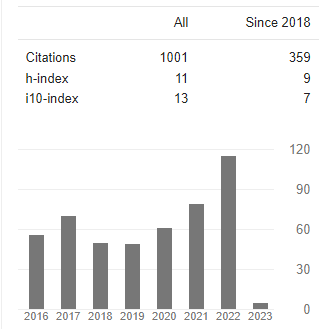EXPLORING FLIPPED CLASSROOM AS PEDAGOGICAL APPROACH: A SYSTEMATIC REVIEW OF LITERATURE
Abstract
The rapid growth in the digitalization and outbreak of COVID pandemic has accelerated the inclusion of technology in education. Higher education in the present world of digitalization faces the challenge of providing high quality education which is cost effective and also caters to the needs of students from diverse backgrounds. Flipped classroom has been positioned as an integrated pedagogical approach which can be implemented in higher education so as to cater to the needs of students of digital world. There is lack of sufficient information regarding implementation designs of flipped classroom. Therefore, present research was conducted to understand the flipped classroom implementation. This paper is a review paper in which a systematic review of implementation designs of flipped classroom has been done. The studies were taken from the year 2010-2023. JSTOR, Springer and Taylor Francis repositories were consulted for the review. A total of 27 review articles were included for conducting the present study. Based on the review the key characteristics of flipped classroom have been determined. The implementation designs of flipped classroom based on systematic review of literature have been discussed. Finally, the best approach for implementing flipped classroom with effectiveness has been assumed.
Downloads
References
Aidinopoulou, V., & Sampson, D.G. (2017). An Action Research Study from Implementing the Flipped Classroom Model in Primary School History Teaching and Learning. Journal of Educational Technology & Society, 20(1), 237–247. http://www.jstor.org/stable/jeductechsoci.20.1.237
Al-Samarraie, H.; Shamsuddin, A. & Alzahrani, A. (2019). A flipped classroom model in higher education: A review of the evidence across disciplines. Educational Technology Research and Development. 68. https://doi.org/10.1007/s11423-019-09718-8.
Ampillo-Ferrer, J.M., Miralles-Martínez, P. (2021). Effectiveness of the flipped classroom model on students’ self-reported motivation and learning during the COVID-19 pandemic. Humanities Social Science Communications 8, 176. https://doi.org/10.1057/s41599-021-00860-4
Backes, S., Baumann, I., Harion, D., Sattler, S., & Lenz, T. (2021). Why flipping the classroom is not enough: Digital curriculum making after the pandemic. Prospects 51, 347–361 https://doi.org/10.1007/s11125-021-09555-9
Baliya, J. N., & Shikha, D. (2023). Implementing Blended Learning Approach for Enhancement of Scientific Attitude of Undergraduate Students. MIER Journal of Educational Studies Trends and Practices, 13(1), 129–146. https://doi.org/10.52634/mier/2023/v12/i1/2275
Bergmann, J., & Sams, A. (2012). Flip your classroom: Reach every student in every class every day. Internal Society for Technology in Education.
Bishop, J., & Verleger, M. (2013). The Flipped Classroom. A Survey of the Research. ASEE Annual Conference & Exposition. http://dx.doi.org/10.18260/1-2--22585
Esperanza, P.T., Himang, C., Bongo, M., Selerio, Jr. E. & Ocampo, L. (2023). The utility of a flipped classroom in secondary Mathematics education. International Journal of Mathematical Education in Science and Technology, 54(3), 382-415, https://doi.org/10.1080/0020739X.2021.1957166
Flipped Learning Network (FLN). (2014). The four pillars of FLIP™. http://www.flippedlearning.org/definition
Flores, Ò., Del-Arco, I. & Silva, P. (2016). The flipped classroom model at the university: analysis based on professors’ and students’ assessment in the educational field. International Journal of Educational Technology in Higher Education, 13, 21. https://doi.org/10.1186/s41239-016-0022-1
Graham, M., McLean, J., Read, A., Suchet-Pearson, S. & Viner, V. (2017). Flipping and still learning: experiences of a flipped classroom approach for a third-year undergraduate human geography course. Journal of Geography in Higher Education, 41 (3), 403-417, https://doi.org/10.1080/03098265.2017.1331423
Hamdan, N., McKnight, P., McKnight, K., & Arfstrom, K. M. (2013). A review of flipped learning. Flipped Learning Network. Pearson Publishers. https://flippedlearning.org/wp-content/uploads/2016/07/LitReview_FlippedLearning.pdf
Hung, H.T. (2017). Design-Based research: Redesign of an English language course using a flipped classroom approach. TESOL Quarterly, 51(1), 180–192. http://www.jstor.org/stable/44986983
Hwang, G.J., & Lai, C.L. (2017). Facilitating and bridging out-of-class and in-class learning: an interactive e-book-based flipped learning approach for math courses. Journal of Educational Technology & Society, 20(1), 184–197. http://www.jstor.org/stable/jeductechsoci.20.1.184
Hwang, G.J., Lai, C.L., & Wang, S.Y. (2015). Seamless flipped learning: a mobile technology-enhanced flipped classroom with effective learning strategies. J. Comput. Educ. 2, 449–473 https://doi.org/10.1007/s40692-015-0043-0
Jesurasa, A., Mackenzie, K., Jordan, H., & Goyder, E. C. (2017). What factors facilitate the engagement with flipped classrooms used in the preparation for postgraduate medical membership examinations? Advances in Medical Education and Practice, 8, 419–426. https://doi.org/10.2147/AMEP.S132266.
Johnston, N., & Karafotias, T. (2016). Flipping the Classroom to Meet the Diverse Learning Needs of Library and Information Studies (LIS) Students. Journal of Education for Library and Information Science, 57(3), 226–238. https://www.jstor.org/stable/90015223
Karabatak, S., &Polat, H.(2020). The effects of the flipped classroom model designed according to the ARCS motivation strategies on the students’ motivation and academic achievement levels. Educ Inf Technol 25, 1475–1495 https://doi.org/10.1007/s10639-019-09985-1
Kurt, G. (2017). Implementing the flipped classroom in teacher education: Evidence from Turkey. Journal of Educational Technology & Society, 20(1), 211–221.
Lage, M.J., Platt, G.J, & Treglia, M. (2000). Inverting the classroom: A gateway to creating an inclusive learning environment. The Journal of Economic Education, 31(1):30–43. http://dx.doi.org/10.1080/00220480009596759
Lapitan Jr., L.DS., Tiangco, C.E., Sumalinoga, D.AG., Sabarilloa, N.S., & Diaz, J.M. (2021). An effective blended online teaching and learning strategy during the COVID-19 pandemic. Education for Chemical Engineers, 25, 116–31. https://doi.org/10.1016%2Fj.ece.2021.01.012
Lee, M.K. (2018). Flipped classroom as an alternative future class model?: implications of South Korea’s social experiment. Educational Technology Research and Development, 66(3), 837–857. http://www.jstor.org/stable/45018664
Li, C.T., Hou, H.T., Li, M.C., & Kuo, C.C. (2022). Comparison of Mini-Game-Based Flipped Classroom and Video-Based Flipped Classroom: An Analysis of Learning Performance, Flow and Concentration on Discussion. Asia-Pacific Edu Res 31, 321–332. https://doi.org/10.1007/s40299-021-00573-x
Lo, C.K. (2018). Grounding the flipped classroom approach in the foundations of educational technology. Education Tech Research Dev, 66(3), 793-811. https://doi.org/l0.100
Mandeep Singh Nathial, Analysis of set shot in basketball in relation with time to perform the course and displacement of center of gravity, American Journal of Sports Science, Vol.2 Issue.5 pp: 122-126 (2014). Retrieved from https://www.sciencepublishinggroup.com/journal/paperinfo.aspx?journalid=155&doi=10.11648/j.ajss.20140205.13
Mandeep Singh (2010). Evaluation And Improvement Of Sports Techniques Through Biomechanical Updated Analyzing Technology, University News, Journal of Higher Education Association of Indian Universities, Association of Indian Universities, Vol:48:Issue.05;2010 Pp45-57, 2010
Mandeep Singh Nathial, A Study of Adjustment and Emotional Intelligence of University Coaches in India, American Journal of Applied Psychology. Volume 3, Issue 6, November 2014 , pp. 122-126. doi: 10.11648/j.ajap.20140306.11
Maxson, K. & Szaniszlo, Z. (2015). An Introduction to the Flipped Classroom, PRIMUS, 25(8), 597-599. https://doi.org/10.1080/10511970.2015.1058307
Moore, A. J., Gillett, M.R., & Steele, M.D. (2014). Fostering Student Engagement with the Flip. The Mathematics Teacher, 107(6), 420-425. https://www.jstor.org/stable/10.5951/mathteacher.107.6.0420
Nouri, J. (2016). The flipped classroom: for active, effective and increased learning – especially for low achievers. Int J Educ Technol High Educ 13(33).https://doi.org/10.1186/s41239-016-0032-z
Ogden, L. (2015). Student perceptions of the flipped classroom in college algebra. PRIMUS, 25(9-10), 782-791. https://doi.org/10.1080/10511970.2015.1054011
Porcaro, P.A., Jackson, D.E., McLaughlin, P.M., &Malley, C.J.O. (2016). Curriculum Design of a Flipped Classroom to Enhance Haematology Learning. J Sci Educ Technol 25, 345–357. https://doi.org/10.1007/s10956-015-9599-8
Prashar, A. (2015). Assessing the flipped classroom in operations management: A pilot study. Journal of Education for Business, 90 (3), 126-138. https://doi.org/10.1080/08832323.2015.1007904
Roehl, A., Reddy, S. L., & Shannon, G. J. (2013). The flipped classroom: an opportunity to engage millennial students through active learning strategies. Journal of Family & Consumer Sciences, 105(2), 44–49.
Rotellar, C., & Cain, J. (2016). Research, perspectives, and recommendations on implementing the flipped classroom. American journal of pharmaceutical education, 80(2), 34. https://doi.org/10.5688/ajpe80234
María Luisa Sein‑Echaluce1 • Ángel Fidalgo‑Blanco2 • Ana María Balbín3 • 4Sein-Echaluce, M.L., Fidalgo-Blanco, Á., Balbín, A.M., &García‑Peñalvo, F. J. (2022). Flipped Learning 4.0. An extended flipped classroom model with Education 4.0 and organisational learning processes. Univ Access Inf Soc. https://doi.org/10.1007/s10209-022-00945-0
Shikha, D.,& Baliya, J.N. (2023). Impact of Blended Learning Strategies on Concept Attainment amongElementary School Students Studying Social Studies - An ExperimentalStudy. Indian Journal of Natural Sciences, 13(76).
Shimamoto, D. (2012). Implementing a flipped classroom: an instructional module. Powerpoint presented at the Technology, Colleges, and Community Worldwide Online Conference. http://hdl.handle.net/10125/22527
SINGH SIDHU, A., & SINGH, M. (2022). KINEMATICAL ANALYSIS OF HURDLE CLEARANCE TECHNIQUE IN 110M HURDLE RACE. International Journal of Behavioral Social and Movement Sciences, 4(2), 28–35. Retrieved from https://ijobsms.org/index.php/ijobsms/article/view/267
Singh, A., & Singh , D. M. (2013). PROMOTION OF RESEARCH CULTURE –ENHANCING QUALITY IN HIGHER EDUCATION. International Journal of Behavioral Social and Movement Sciences, 2(2), 202–208. Retrieved from https://ijobsms.org/index.php/ijobsms/article/view/152
SINGH, M., & SINGH SIDHU, A. (2016). A COMPARATIVE STUDY OF BODY COMPOSITION AND RELATIVE HEALTH STATUS AMONG RESIDENT AND NON-RESIDENT STUDENTS IN DIFFERENT SCHOOLS OF J&K. International Journal of Behavioral Social and Movement Sciences, 5(3), 08–13. Retrieved from https://ijobsms.org/index.php/ijobsms/article/view/320
Sointu, E., Hyypiä, M., Lambert, M. C., Hirsto, L., Saarelainen, M., &Valtonen, T. (2023). Preliminary evidence of key factors in successful flipping: predicting positive student experiences in flipped classrooms. High Educ (Dordr), 85(3):503-520. https://doi.org.10.1007/s10734-022-00848-2.
Song, Y., & Kapur, M. (2017). How to Flip the Classroom – “Productive Failure or Traditional Flipped Classroom” Pedagogical Design? Educational Technology & Society, 20 (1), 292–305. https://www.jstor.org/stable/10.2307/jeductechsoci.20.1.292
Turan, Z., & Akdag-Cimen, B. (2020). Flipped classroom in English language teaching: a systematic review. Computer Assisted Language Learning, 33(5-6), 590-606. https://doi.org/10.1080/09588221.2019.1584117
Wang, Y., Huang, X., Schunn, C.D., Zou, Y.,& Wenguo, A. (2019). Redesigning flipped classrooms: a learning model and its effects on student perceptions. Higher Education, 78 (4), 711-728. https://www.jstor.org/stable/45218107
Wu, W.V., Hsieh, J.S.C.,& Yang, J.C. (2017). Creating an Online Learning Community in a Flipped Classroom to Enhance EFL Learners’ Oral Proficiency. Journal of Educational Technology & Society, 20(2), 142–157. http://www.jstor.org/stable/90002170
Yanjie, S., Morris, S. Y. J., Maiga, C.,& Weiqin, C. (2017). Guest Editorial: “HOW” to Design, Implement and Evaluate the Flipped Classroom? – A Synthesis. Journal of Educational Technology & Society, 20(1), 180–183. http://www.jstor.org/stable/jeductechsoci.20.1.180
Zheng, L., Bhagat, K. K., Zhen, Y., & Zhang, X. (2020). The Effectiveness of the Flipped Classroom on Students’ Learning Achievement and Learning Motivation: A Meta-Analysis. Journal of Educational Technology & Society, 23(1), 1–15. https://www.jstor.org/stable/26915403

Copyright (c) 2023 Deep Shikha, J.N Baliya

This work is licensed under a Creative Commons Attribution 4.0 International License.














